Candlesticks, Part III
by Mark A. Nye
Issue No. 218 - June 1991
This month we shall continue our coverage of candlesticks offered in the final Cambridge Glass Company catalog, issued in late 1956. Pages from this catalog, showing candlesticks, were reprinted in Part II of this article, appearing in the March 1991 issue of the CRYSTAL BALL. As stated in that article, with one exception, all of the candlesticks illustrated in this catalog were first made prior to the demise (in the summer of 1954) of the original Cambridge Glass Company.
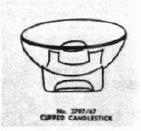 Our first candlestick this month, the #3797/67 cupped candlestick,
from the Cambridge Square line, made its debut with the rest of the
line in January 1952. The first known price list that contains a
listing for the Cambridge Square line is dated January 1953 and the
cupped candlestick, made in crystal only, was listed at $16.80 per
dozen or $1.40 each retail. This price list also included a "Western
Price List" that indicated a wholesale price of $18.40 per dozen and
suggested retail price of $1.55 each. By the fall of 1953, the listed
retail price was $18.00 per dozen.
Our first candlestick this month, the #3797/67 cupped candlestick,
from the Cambridge Square line, made its debut with the rest of the
line in January 1952. The first known price list that contains a
listing for the Cambridge Square line is dated January 1953 and the
cupped candlestick, made in crystal only, was listed at $16.80 per
dozen or $1.40 each retail. This price list also included a "Western
Price List" that indicated a wholesale price of $18.40 per dozen and
suggested retail price of $1.55 each. By the fall of 1953, the listed
retail price was $18.00 per dozen.
Included in the Ebon line when it was introduced in early 1954, ebon being matte finished ebony glass, was the #3797/67 candlestick known simply as Ebon #67. Listed at $2.00 each plain, it was also available at $3.00 each with D/1 (Birds) and D/2 (Stars).
Prices continued to increase and in 1958, the final list price for the #3797/67 cupped candlestick was $24 per dozen. While a couple of items from the Cambridge Square line were made in carmen, the #67 candlestick was not one of them and will be found only crystal and ebon. (It should be noted here that the Imperial Glass Company, in approximately 1969, did produce this candlestick in their Ruby color and several have been found with their label which reads "Genuine Handmade Cambridge by Imperial.")
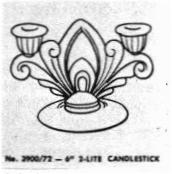 The #3900/72 6" 2-lite candlestick first saw the light of day as
Caprice #72, sometime after January 1940, as that was when the mold was
ordered. When the mold was completed and first used is not known;
however, the first catalog illustration of the candlestick is on a page
dated June 1941 and it is captioned "Caprice #72 6" 2-lite
candlestick." Prior to that, however, the candlestick was pictured in
the April 1941 issue of "Crockery and Glass Journal." During the years
it was made as a part of the Caprice line, this candlestick was made in
crystal and moonlight, plain and Alpine.
The #3900/72 6" 2-lite candlestick first saw the light of day as
Caprice #72, sometime after January 1940, as that was when the mold was
ordered. When the mold was completed and first used is not known;
however, the first catalog illustration of the candlestick is on a page
dated June 1941 and it is captioned "Caprice #72 6" 2-lite
candlestick." Prior to that, however, the candlestick was pictured in
the April 1941 issue of "Crockery and Glass Journal." During the years
it was made as a part of the Caprice line, this candlestick was made in
crystal and moonlight, plain and Alpine.
The #3900 or Corinth line was conceived during late 1942 and the first mold orders were placed in January 1943. Apparently the line was not sold commercially until 1949, as there is no mention of it in the trade publications until that year. At this time, it has not been determined if the #72 candlestick, as a part of the Caprice line, was discontinued prior to its appearance in the Corinth line. As Corinth, the #3900/72 was made only in crystal, plain and with various etchings and rock crystal engravings.
As Caprice #72, this particular candleholder was used as the basis for the Caprice #78 and #79 2-lite candelabra. These two differ only in the bobeches used: #78 used the #23 bobeche; while the #79 used the #19. Both did use #1 prisms. This same candlestick, when combined with two arms and four vases became the #667 epergne and all three of these items were available during the early to middle 1940s.
Even though the #72 candlestick, Caprice or Corinth, was first made in the early 1940s and remained in the Cambridge line until the last closing, it is not an easy one to locate today.
Three other old friends found on the pages of the 1956-58 catalog are candlesticks #1457, #1357 and #1338. The origins of these pieces are most likely lost to us; however, the #1338 first appears in the 1933 Cambridge Catalog supplement as a part of the #3500 or Gadroon line, while #1357 is found on a page dating to 1934. The #1457 cannot be found in the 1930-34 Cambridge catalog, but, based on its similarity to the #1357, was probably brought out at about the same time. It is, however, pictured in the 1940 catalog. I suspect these candleholders may have been copied from a European import, but I have no evidence to support such a conclusion.
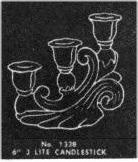 The #1338 3-holder candlestick (aka the step candlestick) is shown
on the 1933 catalog page with crosshatching on the balls supporting the
candle pockets. This apparently was eliminated when a replacement mold
for this item was made during 1942, as the crosshatching is not seen in
illustrations dating to the late 1940s and 1950s.
The #1338 3-holder candlestick (aka the step candlestick) is shown
on the 1933 catalog page with crosshatching on the balls supporting the
candle pockets. This apparently was eliminated when a replacement mold
for this item was made during 1942, as the crosshatching is not seen in
illustrations dating to the late 1940s and 1950s.
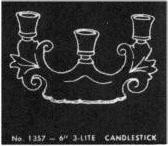 Three years after its appearance with the Gadroon line, the #1338
3-lite candlestick was shown on Caprice catalog pages as was the #1357.
During the ensuing years, both candlesticks were offered as part of the
Caprice line, as well as, "independent" candleholders. Strictly
speaking, these two candlesticks are, for a couple of reasons, not a
part of the Caprice line. One, they both predate the Caprice line, and
two, the pattern, while similar to the Caprice design, is not true
Caprice.
Three years after its appearance with the Gadroon line, the #1338
3-lite candlestick was shown on Caprice catalog pages as was the #1357.
During the ensuing years, both candlesticks were offered as part of the
Caprice line, as well as, "independent" candleholders. Strictly
speaking, these two candlesticks are, for a couple of reasons, not a
part of the Caprice line. One, they both predate the Caprice line, and
two, the pattern, while similar to the Caprice design, is not true
Caprice.
As Caprice #1338, this candlestick was made in crystal, moonlight and la rosa, plain and alpine, and in later years in mandarin gold and late emerald. With the coming of milk glass, #1338 was made in that color and called W91. The #1357, as Caprice, was issued in crystal and moonlight, plain and alpine. When listed simply as #1338, the 1940 price list gave color availability as crystal, amber, dianthus pink, moonlight and royal blue. Other colors are possible, especially from 1930s production, and I believe I have seen it in crown tuscan.
The #1338 will be found etched Rosepoint, and it is subject to debate if such pieces should be referred to as etched Caprice. My feeling is no; that in such instances the candlestick was sold as a stand alone item and not as a part of the Caprice line.
The #1338 will also be found with the gold decoration D/1018, gold stippled edge.
The #1338 was combined with an arm and two vases to make the #668 3-lite epergne during the early 1940s and perhaps before. By January 1953, #1338 was being made only in crystal and the suggested retail price was $42 per dozen. Five years later, the final price was $48 per dozen.
The #1357 6" 3-lite candlestick was often combined with bobeches, prisms, arms and vases, to form various candelabra and epergnes, there being at least five. These varied mainly by the type and number of bobeches and the type and number of prisms used and are the #1354/27, #1354/19, #1358, and the #1358/8 and #1358/5 epergnes. The latter two differ only by the arm that was used. The former uses an arm with a center candle pocket while the latter uses an arm without a center candle pocket. (It has in the center what could be called a "handle.") By 1956, all but the #1358 had been discontinued.
In 1940, the most expensive items in this group was the #1354/27, consisting of three #27 bobeches, 18 #5 prisms and the 3-lite candlestick selling for $135 per dozen; and the #1358/8 epergne with its #1438 arm, two #19 bobeches and 16 #1 prisms, and two vases selling for the same price. For comparison, the candlestick itself was listed at $40 per dozen. By 1958, the #1358 candelabra with two #19 bobeches and 16 prisms was listed at $219 per dozen, compared to $112.50 per dozen in 1940.
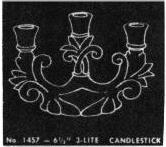 The #1457 candlestick varies from the #1357 only in that the center
candle pocket is higher than the outer two rather than lower as is the
case with the #1357. This candlestick apparently was never listed with
the Caprice, and indications are it was only made in crystal.
The #1457 candlestick varies from the #1357 only in that the center
candle pocket is higher than the outer two rather than lower as is the
case with the #1357. This candlestick apparently was never listed with
the Caprice, and indications are it was only made in crystal.
The #1457, like the #1357, was made into epergnes and candelabrum
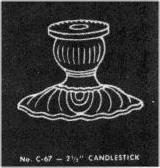 and a good example is the #1568 11" 5-lite candelabrum consisting of
the candlestick, five #19 bobeches, 40 #7 prisms and two #1432 arms.
All of this, in 1940, was priced at $345 per dozen or $28.75 each. For
the time, this was a great deal of money and, it is understandable, not
a large number were sold. However, apparently enough were sold, since
18 years later this candelabrum, with different prisms, was still in
the Cambridge line, priced at $36.00 each.
and a good example is the #1568 11" 5-lite candelabrum consisting of
the candlestick, five #19 bobeches, 40 #7 prisms and two #1432 arms.
All of this, in 1940, was priced at $345 per dozen or $28.75 each. For
the time, this was a great deal of money and, it is understandable, not
a large number were sold. However, apparently enough were sold, since
18 years later this candelabrum, with different prisms, was still in
the Cambridge line, priced at $36.00 each.
Another familiar item is the Caprice #67 single light candlestick brought out with the Caprice line in 1936. It may be found in crystal, la rosa and moonlight, plain and alpine. It was a relatively inexpensive candlestick, when plain, selling for $4 per dozen and in 1940 and in 1958 the retail price was only 90 cents each.
If you preferred the Caprice pattern with the alpine decoration, the #67 candlestick would then cost you, in 1940, $7.50 per dozen ...
To be continued ...
